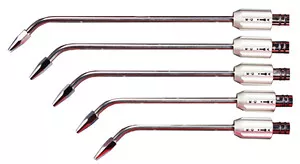- Stick electrodes 59
- MIG/MAG solid wires 36
- MIG/MAG flux-cored wires 49
- TIG rods 34
- Thermal spraying 39
- Solders & fluxes 64
- Hardfacing 21
- Polymer coatings 9
- Welding torch 128
- Welding equipment 21
- Plasma cutting 15
- Oxyfuel technology and gas supply 1
- Welding accessories 6
- Occupational health and safety 11
Thermal Spraying Devices
Thermal spraying is a versatile coating process used to enhance the surface properties of materials, such as improving wear resistance, corrosion resistance, and thermal protection. The process involves heating and accelerating particles of the coating material and projecting them onto a substrate to form a dense, protective layer. Various methods can be used in thermal spraying, including:
- Plasma Spray: Utilizes a high-temperature plasma jet to melt and propel the coating material onto the substrate. Suitable for high melting point materials like ceramics and refractory metals.
- High-Velocity Oxy-Fuel (HVOF) Spray: Combines fuel and oxygen to produce a high-velocity flame that melts the coating material. Ideal for producing dense, hard coatings with excellent bond strength.
- Flame Spray: Uses a combustion flame to melt the coating material, which is then sprayed onto the substrate. Commonly used for applying metal and ceramic coatings.
- Arc Wire Spray: Involves an electric arc to melt wire feedstock, which is then atomized and sprayed onto the substrate. Suitable for large-scale applications and anti-corrosion coatings.
- Cold Spray: Uses high-pressure gas to accelerate powder particles to supersonic speeds, causing them to plastically deform and bond upon impact. Ideal for temperature-sensitive substrates.
Advantages of Thermal Spraying Devices:
- Mechanical Interlocking and Diffusion: Achieves strong adhesion with negligible overall heat input, minimizing component distortion.
- Versatility: Suitable for a wide range of materials including metals, ceramics, and polymers.
- High Productivity: Capable of high deposition rates and efficient coating processes.
- Safety and Reliability: Incorporates safety features such as quick shut-off levers and strict quality control.


